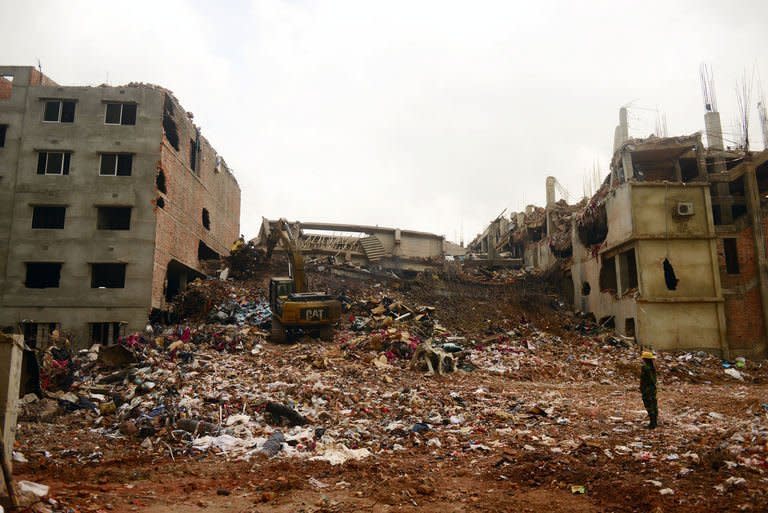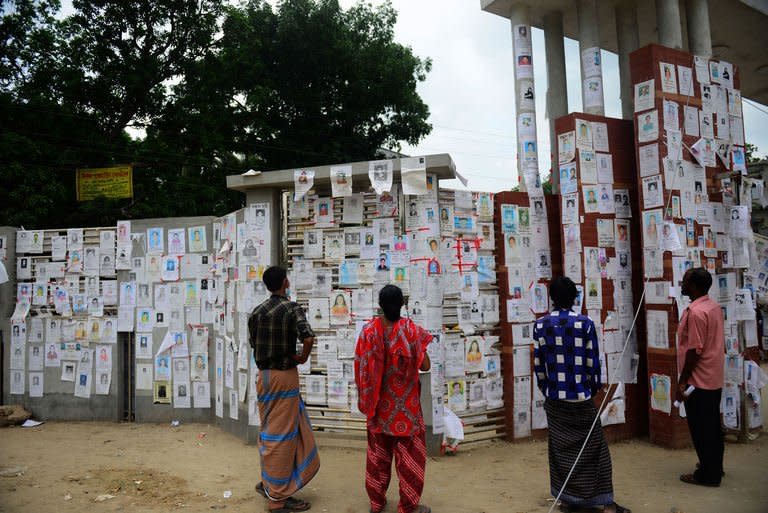Bangladesh building collapse death toll passes 620
The death toll from Bangladesh's worst industrial disaster surpassed 620 Sunday after dozens more bodies were pulled from the wreckage of a nine-storey building that housed garment factories. Search teams said the toll would almost certainly rise since debris had only been cleared down to the fifth floor of the pancaked building, and a strong stench from lower floors suggested more bodies would be found. Lieutenant Imran Khan of the army control room coordinating the rescue told AFP the confirmed death toll now stands at 622 after 53 bodies were pulled out on Sunday. The Rana Plaza building, which housed five garment factories, collapsed at Savar near the capital Dhaka on April 24. More than 3,000 people, mostly women workers sewing clothing for Western brands such as Mango, Benetton and Primark, were working inside at the time. Police have charged the building owner Sohel Rana and five factory owners with causing death due to negligence and violating construction laws, charges punishable by a maximum seven years in jail. The wife of a male garment worker killed in the disaster has also filed a murder complaint against Rana, one of the garment factory owners and a municipal engineer. Senior judicial magistrate Wasim Sheikh Sunday accepted the complaint by Sheuli Akter and ordered an investigation, police Inspector Mohammad Asaduzzaman told AFP, adding the three face death by hanging if convicted of murder. Rana, a local leader of the ruling Awami League political party, was arrested after a four-day hunt as he tried to flee to India. Hundreds of distraught relatives gathered at the site Sunday as cranes and bulldozers cut through a mountain of concrete and mangled steel. Mohammad Jashim, 25, whose garment worker sister Jakiya Begum was still missing, was among them. Every time a body was recovered he rushed to see whether the remains were those of his sister. "I won't leave without her bones. She was like a mother to me," he told AFP. Officials said some bodies pulled from the wreckage have missing limbs and some have decomposed, delaying identification. "We've identified only a handful of them by their mobile phones that were found in their pockets or identity cards given by the factories," deputy administrator of Dhaka district, Zillur Rahman Chowdhury, told AFP. Military rescuer Major Delwar Hossain said the stench at the site suggested more corpses were trapped under the rubble, forcing search teams from the army and fire services to wear masks. "The foul odour is so strong you cannot work there without wearing masks and using air fresheners," Hossain said. "More and more bodies are being found underneath the debris as we are removing debris from upper floors to make it to the lower floors," he said. Commerce Secretary Mahbub Ahmed late Saturday reiterated pledges to "inspect all garment factory buildings" as Bangladesh faces pressure from Western brands to clean up an industry with a shocking accident record. The government made a similar announcement after a devastating fire exactly five months ago killed 111 garment workers, but the subsequent inspections were widely derided as insufficient. Ahmed urged buyers and top trade partners such as the European Union, where nearly 60 percent of Bangladesh's clothing is shipped, not to shun Dhaka's products. He said any boycott would hurt the country's 60 million poor. A preliminary government probe has said the collapse was caused by vibrations from four giant generators on the compound's upper floors. The building's architect, Masood Reza, told AFP he designed the structure to house a shopping mall and offices, not factories. UK retailer Primark, Italy's Benetton and Spanish firm Mango have admitted they had placed orders with the factories based in the compound, triggering an angry response in many Western countries. Bangladesh is the world's second-largest garment exporter after China. The industry accounts for 80 percent of the country's exports and more than 40 percent of its industrial workforce.




